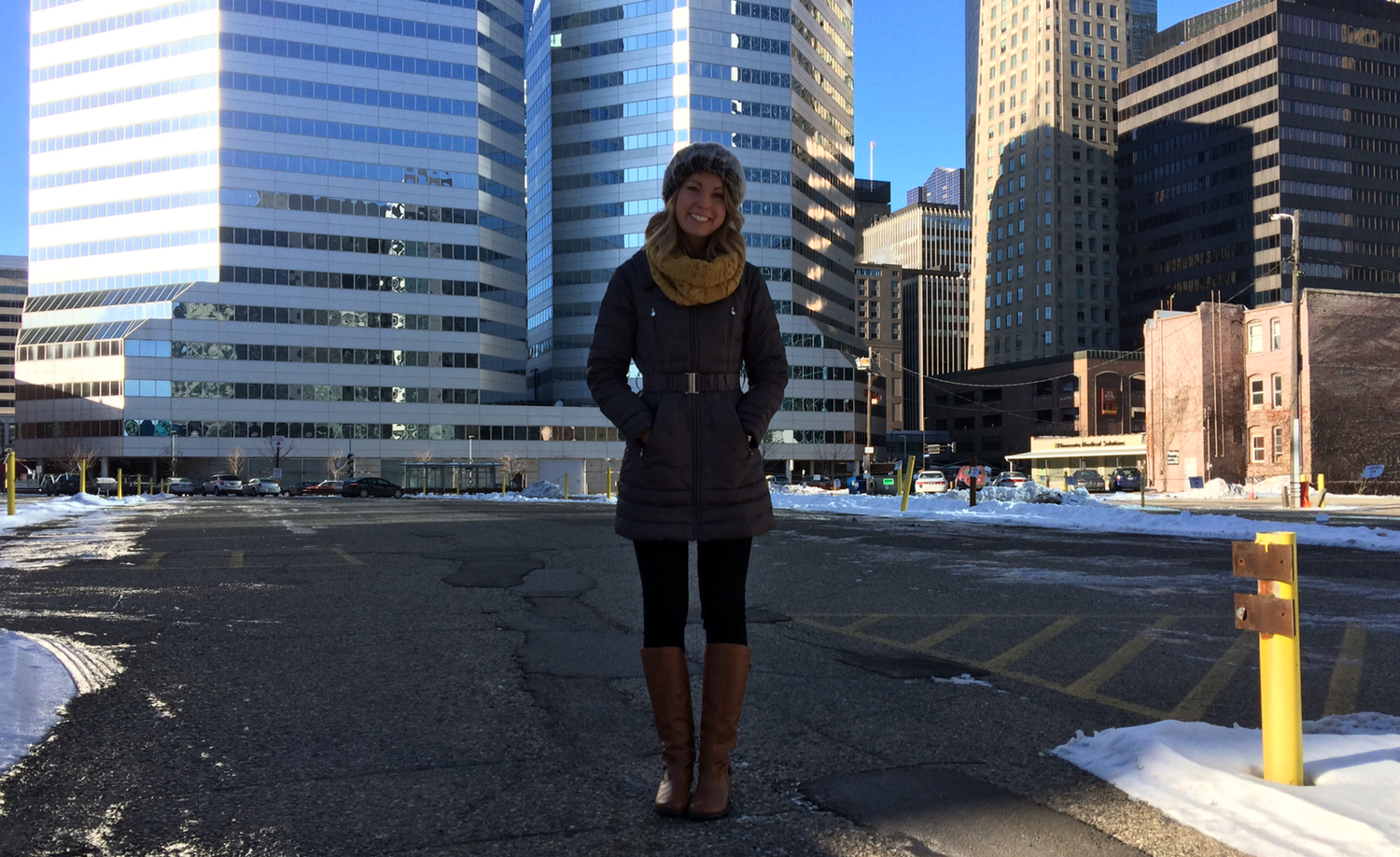Young talent continues to flee Michigan
It's not as if Sarah Noffze dislikes Michigan.
After all, she grew up in suburban Detroit, went to Michigan State University and served on the homecoming court. She remains loyal to her beloved Sparty.
But as she neared graduation in 2014, the marketing major set her sights on a job elsewhere.
“My original goal was to move someplace warmer. I was thinking maybe California,” recalled Noffze, 22.
But in early 2015, Noffze landed a job at Hormel Foods in Minneapolis, where she is now a regional retail sales manager. She gets the irony.
“Hormel ended up offering me a full-time job,” she said. “I couldn't turn down the offer.”
And now? She doesn't mind the cold – while growing to appreciate the array of diversions that Minneapolis offers.
“There's always lots of things to do ‒ beer fests, a Shania Twain concert, Christmas parades. There's lots of young people living here, which is very attractive to me. There's actually lots of people from Michigan and Michigan State here.”
As Noffze said, she has plenty of company.
According to the U.S. Census, Michigan had a net domestic migration loss of 38,911 people in the one-year period from July 2014 to July 2015. Translation: That's how many more people left for other states than moved in. That’s the sixth highest population loss in the nation.
And just as notably, Michigan continues to lose a particularly valuable human resource: Young people with college degrees.
Census figures show that Michigan had an estimated net migration loss of 0.7 percent of those age 22-to-34 with a bachelor's degree or higher.
While that’s less of a percentage loss than previous years, it extends a troubling pattern of young, educated people leaving the state in greater numbers than those coming to Michigan.
“We are still seeing young people, especially people from elite universities, going elsewhere,” said demographic expert Kurt Metzger, director emeritus of Data Driven Detroit, a low-profit limited liability research organization.
“They have so many more options. We are just not capturing those people,” said Metzger, now mayor of Pleasant Ridge, which borders Detroit.
Loss of talent, loss of clout
The overall exodus has been in play for more than a decade, a drain that reflects the economic struggles of a Rust Belt state and results in a continued loss of national political clout. Since 2001, more than 700,000 more people have left Michigan than have moved in, even as overall population in the state has begun to slowly rise.
Gov. Jennifer Granholm pointed to the issue in 2003, when she launched her “Cool Cities” initiative, which channeled state funds to local governments for projects to make their cities attractive to young knowledge workers. The amounts were modest – in its first year, 2004 – the state awarded $1.9 million in state funds for 19 projects.
Dave Murray, spokesman for Gov. Rick Snyder, said Snyder is well aware what’s at stake.
“One of the things that inspired the governor to run was that his children were approaching college age and he – like most parents – wanted them to be able to find good jobs and remain in Michigan after graduation,” Murray said in an email.
Murray noted there are more than 80,000 jobs posted on the state’s employment site, figures that the governor’s office has cited for years.
“One of the governor’s priorities is to increase the collaboration between businesses, higher education and K-12 districts so students can graduate with in-demand skills for the jobs of today and tomorrow. Our challenge is to make sure our college graduates have the skills to fill those jobs and stay here in Michigan.”
Doug Rothwell, president and CEO of Business Leaders for Michigan, the state's business roundtable, called the ongoing loss of young professional talent a “serious demographic crisis that threatens economic growth as our workforce ages and population growth is stagnant.”
In a statement, he added: “We believe the best long-term solution is to grow more good jobs in growth industries and to boost college enrollments. There is no better tool than good-paying jobs in growing industries for attracting people to come here for work and attracting more students to go to school here in Michigan.”
Metzger, the demographer, said population projections show Michigan will lose one more congressional seat in 2020, which would leave it with 13. The state had 19 in 1970 – and has lost at least one seat every decade since then. Metzger sees nothing on the horizon to reverse that trend.
“The way the (national) population continues to grow in the South and Southwest, there's no likelihood we could make up the numbers between now and 2020.”
Susan Demas, publisher of Inside Michigan Politics, a Lansing political newsletter, said the loss of another congressional seat would be one more reminder how this once-mighty manufacturing state has fallen.
“It shows that our state continues to struggle, even as we've clawed our way out of a decade-long recession,” Demas said. “We're still not retaining and attracting people, which is a fault line in Michigan's economic growth.
“The second problem is that we'd probably lose clout in Washington...The auto bailout of 2008 probably wouldn't have happened if the strong Michigan delegation hadn't flexed its muscles.”
Heading South and West
Even as more people left than entered Michigan from other states, Michigan's overall population nudged up in 2015, to 9,922,576 – a .06 percent rise.
That's because Michigan had more births than deaths and 24,000 in international migration – leaving it with a net population gain of 6,270. That's better than losing people, but ranks just 44th in the nation in percentage growth. It is less than a tenth of the U.S. average rise of .73 percent, a disparity that is expected to continue – hence the loss of another congressional seat.
It's worth noting that Michigan's overall population has now grown, if slightly, for four straight years, after seven consecutive years of losses. But it's also true the 2015 total still stands below the 2000 state population of 9,952,450.
If it's any consolation, Michigan has ample company in the Midwest and Northeast.
The 12-state Midwest, which includes North and South Dakota, Nebraska, Kansas, Minnesota, Iowa, Missouri, Wisconsin, Illinois, Indiana, Ohio and Michigan, lost nearly 240,000 people to domestic migration from 2014 to 2015, while the Northeast lost about 325,000.
New York led the nation in domestic migration loss from 2014 to 2015, with about 157,000, with Illinois second at 105,000.
The biggest winners: Florida, which gained just over 200,000 in domestic migration in that year; and Texas, which gained about 170,000, underscoring gains across the South and West.
Metzger said the migration losses in Michigan are surely linked to the plunge in manufacturing jobs over the first decade this century, a steeper fall than in any other state. According to Michigan's Department of Technology, Management & Budget, Michigan shed more than 430,000 manufacturing jobs from 1999 to 2009, tumbling from nearly 900,000 jobs in 1999 to 463,100 in 2009. The state lost more than 700,000 jobs of all types during that time.
In 2008 and 2009, in the depth of the Great Recession, Michigan lost a net of nearly 200,000 people to other states.
Finding reasons to stay
Though the economy has since revived – with an unemployment rate of 5.1 percent in November 2015 compared with nearly 12 percent five years ago – Metzger said Michigan continues to lose out to regions and cities that young professionals find more enticing places to live.
“You have places like Austin, Houston, Dallas, places with very dynamic economies,” Metzger said. “Cities like Denver and Salt Lake City are investing in regional transit. These cities and regions are getting the importance of investing in infrastructure. Millennials want bike lanes and they want mass transit, all these things we keep hearing from millennials.”
Lou Glazer, president and co-founder of Michigan Future Inc., a nonprofit Ann Arbor-based economic research organization, said Michigan can ill afford to lose this race for young, well-educated professionals. He noted that Michigan ranks 35th in per capita income and 34th in the portion of adults with a college degree.
“We are now in a knowledge-driven economy,” Glazer said. “The common characteristic, except for a few driven by high energy prices, of prosperous states is a high proportion of adults with a four-year degree or more. Young talent particularly are concentrating in vibrant central cities.”
He added: “Michigan needs to have big cities, Detroit and Grand Rapids mainly, that provide quality basic services and amenities; terrific alternatives to driving; density; and being welcoming to all. Combine those features with an entrepreneurial culture and you have a place where talent – from across the planet – wants to live and work.”
On the knowledge front, Michigan has a ways to go. Of 171 cities with over 150,000 population, Detroit ranked 159th in percentage of those 25 to 34 with a bachelor's degree in 2013. Grand Rapids fared better, at 53rd.
In Grand Rapids in 2013, just over 40 percent of those age 25 to 34 had a bachelor's degree. Just 15.9 percent in that age group had a college degree in Detroit. By comparison, Minneapolis ranked 17th in the nation at 56 percent, while nearly 71 percent in that age group in San Francisco had college degrees.
Perhaps counter-intuitively, analysts attribute some flight from Rust Belt cities to an improving economy, which brings with it rising home values. That allowed homeowners who had been frozen in place because their houses were “underwater” – worth less than their mortgage – to sell, and move to warmer climes. In Michigan, nearly 40 percent of mortgages in 2010 were underwater, compared with about 20 percent today.
That wasn't an issue for former Kentwood resident Charlie Scarborough. Scarborough and his wife, Crissy, pulled up stakes in Michigan for one simple reason: He found a better job with better pay in Wisconsin.
“We really liked it in West Michigan,” said Scarborough, 55, who lived in Michigan 21 years before moving in 2015 to a small Wisconsin community south of Green Bay.
He is now a regional business director for Mercury Marine, a manufacturer of marine engines, a step up in pay and responsibility from his former job as supply chain manager for Atwood Marine near Grand Rapids.
Scarborough recalled that his former Michigan employer shrunk to half its size during the Great Recession, years he described as a “pretty scary time.”
And though Atwood has since rebounded, and his position was secure, Scarborough said the opportunity in Wisconsin was too enticing to ignore.
“It was a hard decision to leave. But this was too big and too good a career move to pass up.”
Parker Murasky, 23, is a 2014 graduate of Michigan State University. With a degree in construction management, the Rochester native said goodbye to Michigan that year to take a job with an engineering firm in Vail, Colo.
A few months later, he landed a job as a construction safety engineer with a firm in San Diego. With an apartment about a mile from the Pacific Ocean, he's taken up sailing and surfing. He laughs at the locals who bundle up when the temperature is in the 60s, as if that qualifies as cold weather.
Murasky said he might consider moving back to Michigan some day. But for now, life feels alright in California.
“Michigan is a good place to raise a family so maybe I would move back for that,” he said. “But for the time being, I really enjoy being some place different.”
See what new members are saying about why they donated to Bridge Michigan:
- “In order for this information to be accurate and unbiased it must be underwritten by its readers, not by special interests.” - Larry S.
- “Not many other media sources report on the topics Bridge does.” - Susan B.
- “Your journalism is outstanding and rare these days.” - Mark S.
If you want to ensure the future of nonpartisan, nonprofit Michigan journalism, please become a member today. You, too, will be asked why you donated and maybe we'll feature your quote next time!


 Sarah Noffze, 22, a 2014 graduate of Michigan State University, said she was happy to land a full-time job in Minneapolis, where there’s lots to do despite the cold. (Courtesy photo)
Sarah Noffze, 22, a 2014 graduate of Michigan State University, said she was happy to land a full-time job in Minneapolis, where there’s lots to do despite the cold. (Courtesy photo) Demographic expert Kurt Metzger: “We are still seeing young people, especially people from elite universities, going elsewhere.” (Courtesy photo)
Demographic expert Kurt Metzger: “We are still seeing young people, especially people from elite universities, going elsewhere.” (Courtesy photo) Charles Scarborough, pictured here at a New York City boat show, left Michigan for a sales director with Wisconsin-based Mercury Marine. (Courtesy photo)
Charles Scarborough, pictured here at a New York City boat show, left Michigan for a sales director with Wisconsin-based Mercury Marine. (Courtesy photo) Michigan State University graduate Parker Murasky, hired as a safety engineer in San Diego, has taken advantage of the climate to learn sailing. (Courtesy photo)
Michigan State University graduate Parker Murasky, hired as a safety engineer in San Diego, has taken advantage of the climate to learn sailing. (Courtesy photo)